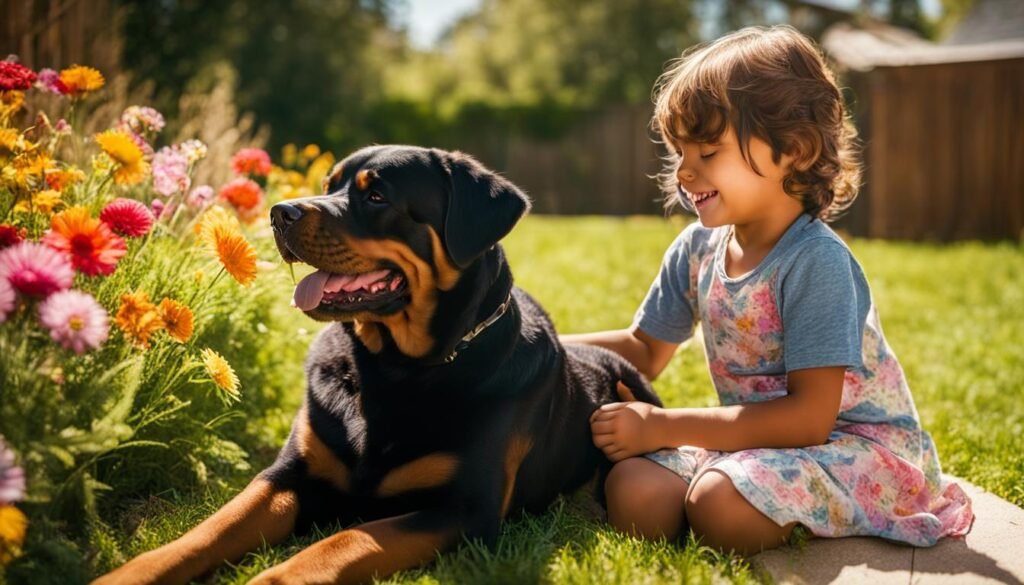Hello, I’m here to answer a common question that many families ask: Are Rottweilers good with kids? As a professional in the world of pet safety, I understand the importance of finding a suitable and safe companion for your children. Let’s dive into the behavior and temperament of Rottweilers around kids, ensuring a harmonious relationship between your family and this beloved breed.
Key Takeaways:
- Rottweilers can be safe and loving around children when properly trained and socialized.
- Supervision during interactions between Rottweilers and kids is crucial, especially with younger children.
- Teaching both the dog and the children how to interact safely and respectfully is important.
- Early socialization and training are key to ensuring a well-behaved Rottweiler around kids.
- Establishing rules and boundaries for interactions is crucial for the safety of both the child and the dog.
Understanding the Rottweiler Breed: Beyond the Stereotypes
Rottweilers are a remarkable breed known for their impressive strength, unwavering loyalty, and innate protective instincts. Originating from Germany, these resilient dogs were primarily utilized for herding livestock and pulling carts.
When considering the compatibility of Rottweilers with children, it is crucial to look beyond the prevalent stereotypes associated with the breed. While they are often portrayed as aggressive or dangerous, it is essential to understand their true temperament and characteristics.
Strength: Rottweilers possess exceptional physical strength, making them ideal working dogs in various capacities. However, their strength should not be misconstrued as a predisposition towards aggression. With proper training and socialization, Rottweilers can thrive in family settings and develop deep bonds with their human counterparts.
Loyalty: Rottweilers are renowned for their unwavering loyalty towards their families. They are known to be fiercely protective, willing to defend their loved ones at all costs. While this protective nature is a desirable trait, it requires responsible ownership and proper training to channel it appropriately.
Protective Instincts: The remarkable protective instincts of Rottweilers make them excellent guardians when trained and socialized appropriately. It is important to note, however, that their protective nature should not be misconstrued as aggression. These instincts can be harnessed in a positive and controlled manner.
Temperament: Rottweilers exhibit a unique combination of calmness and confidence, traits that contribute to their excellent suitability for family environments. When raised with children from a young age and provided with proper training and socialization, Rottweilers can be gentle, affectionate, and reliable companions.
Understanding the true essence of the Rottweiler breed beyond stereotypes is crucial when assessing their compatibility with children. By appreciating their strengths, loyalty, and protective instincts, we can unlock the potential for harmonious relationships between Rottweilers and families.
To further illustrate the charm and appeal of this remarkable breed, take a look at the image below:
Rottweiler Temperament: Are They Safe for Kids?

When it comes to considering Rottweilers as family pets, their temperament and behavior around kids play a significant role. With proper training and socialization, Rottweilers can be loving and gentle with family members, including children. Early socialization and training are key to ensuring a well-behaved Rottweiler around kids.
Rottweilers are known for their calm and confident demeanor. Their inherent loyalty and protective instincts can make them excellent companions for children when properly channeled. However, it is important to remember that like any other dog breed, individual variations exist, and generalizations may not always hold true.
Introducing them to various environments, people, and experiences from a young age helps them develop the necessary social skills and adaptability. Socialization should include supervised interactions with children, exposing the dog to their presence, sounds, and movements in a controlled manner.
Training for a harmonious relationship
In addition to socialization, consistent training is crucial for a Rottweiler’s behavior around kids. Basic commands such as sit, stay, and come are essential to establish boundaries and maintain control in various situations. By teaching the dog to respond to commands, you can ensure their safety and the safety of the children.
Positive reinforcement methods work best with Rottweilers. Rewarding desired behaviors with treats, praise, and affection helps reinforce good behavior. Consistency and repetition are key to successful training. Patience, understanding, and compassion are essential, as Rottweilers thrive under firm yet gentle guidance.
Supervision is crucial
While Rottweilers can be gentle and loving with children, their size and strength should not be overlooked. Supervision is always necessary when Rottweilers interact with young children. This ensures the safety of both the child and the dog, as any inadvertent rough play or misunderstanding can lead to accidents.
Teaching children how to interact safely and respectfully with dogs is equally important. Establishing ground rules, such as not pulling on the dog’s ears or tail, not bothering them while eating or sleeping, and not trying to ride or climb on them, helps maintain a harmonious relationship between the dog and the child.
By prioritizing socialization, proper training, and supervision, you can create a safe and nurturing environment for both Rottweilers and children. Remember, every dog is unique, and individual temperaments may vary. It is crucial to assess the temperament and behavior of each Rottweiler individually, taking into consideration their upbringing and experiences.
The Importance of Training and Socialization in Rottweilers
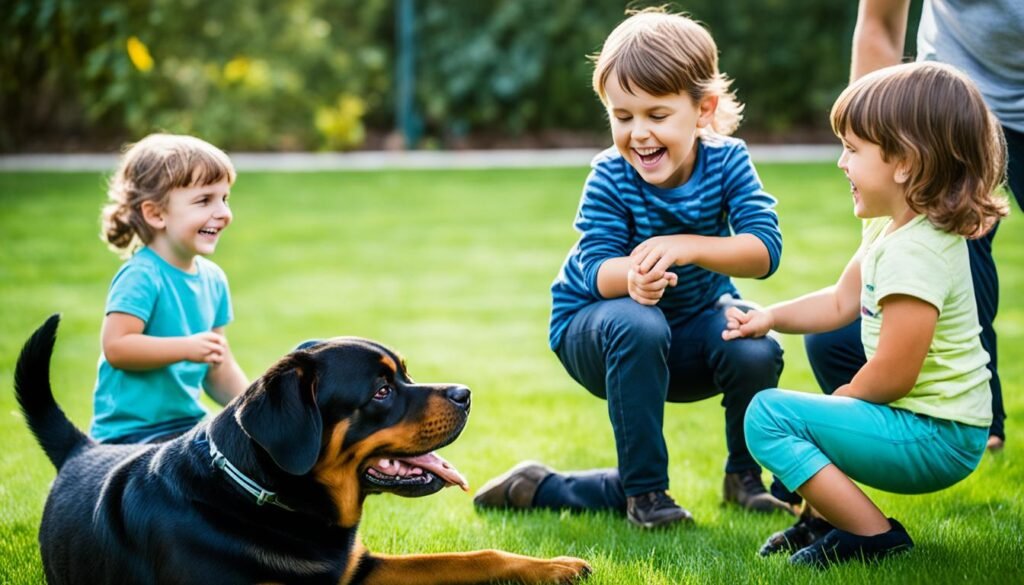
Training and socialization play a vital role in raising well-behaved and balanced Rottweilers, particularly in households with children. It is essential for these majestic dogs to learn appropriate behavior around kids and become accustomed to various situations from an early age. Adequate training and socialization contribute to a calm and well-mannered Rottweiler who can confidently interact with children.
Rottweiler training starts with establishing clear communication and consistent boundaries. Teaching basic commands such as sit, stay, and down helps create a strong foundation for further learning. Positive reinforcement methods, such as praise and rewards, work effectively with Rottweilers, as they respond well to encouragement and motivation.
Proper socialization is equally important, as it exposes Rottweilers to different environments, people, and other animals. Early socialization helps them develop into confident and sociable dogs who can comfortably navigate various situations. Introducing Rottweilers to children of different ages, sizes, and temperaments helps them learn how to interact appropriately and understand boundaries.
Regular exercise and mental stimulation are also crucial components of a Rottweiler’s training regimen. These intelligent and energetic dogs require physical activity to release their pent-up energy and prevent behavioral issues. Engaging in playtime, interactive toys, and structured walks not only provides necessary exercise but also fosters the bond between the Rottweiler and the family.
The Benefits of Training and Socialization
- Improved Behavior: Proper training and socialization enable Rottweilers to develop good manners, reduce unwanted behaviors, and respond positively to commands.
- Confidence and Calmness: Rottweilers who have undergone thorough training and socialization tend to be more self-assured and exhibit a calm and balanced temperament.
- Better Adaptability: Exposure to various environments, people, and animals during socialization helps Rottweilers adapt more easily and remain calm in different situations.
- Enhanced Safety: A well-trained Rottweiler who understands how to interact respectfully with children minimizes the risk of accidents or mishaps.
- Strengthened Bond: Engaging in training activities and socialization exercises creates a deeper bond between the Rottweiler and the family, promoting a harmonious household.
By prioritizing training and socialization, Rottweiler owners can raise a well-adjusted and reliable family companion. Consistency, positive reinforcement, and early intervention are key in shaping a Rottweiler’s behavior and ensuring their interactions with children are safe, enjoyable, and enriching for all involved.
Supervising Interactions: Rottweilers with Young Children
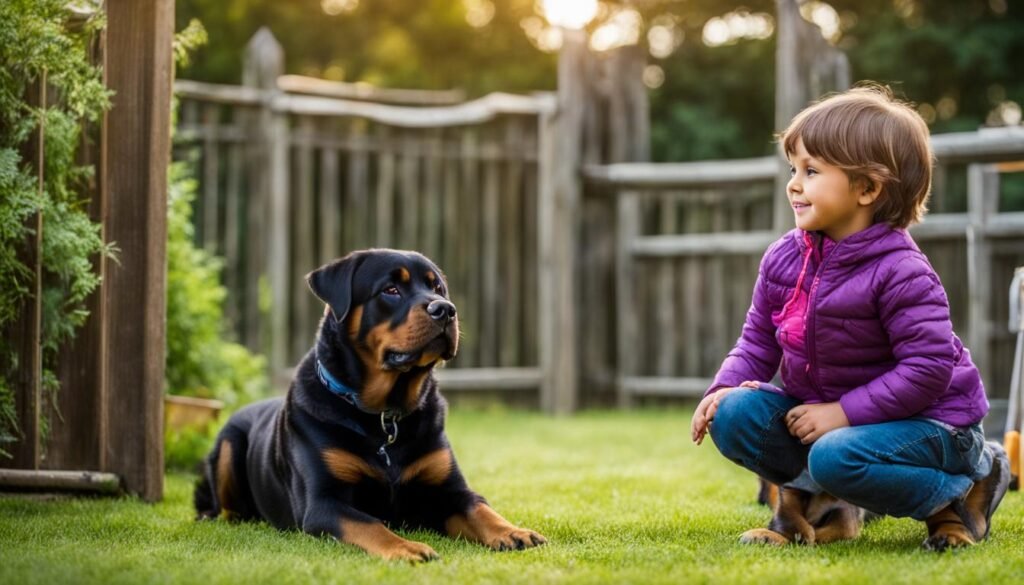
When it comes to interactions between Rottweilers and young children, supervision is the key to ensuring safety for everyone involved. Due to their size and strength, Rottweilers should always be closely monitored during interactions with kids.
Teaching children how to interact safely with dogs is just as important as training the Rottweiler. It’s essential to establish clear rules and boundaries to ensure a positive and safe interaction. By teaching children to approach Rottweilers calmly, avoid sudden movements, and respect their space, we can reduce the risk of accidents or misunderstandings.
Supervision also allows us to understand the communication cues and body language of both the child and the Rottweiler. It’s crucial to watch for any signs of discomfort or stress from either party during the interaction.
H3: Tips for Safe Interactions with Rottweilers:
- Always supervise Rottweiler and child interactions closely.
- Teach children to approach Rottweilers calmly and to avoid sudden movements that may startle the dog.
- Teach children to avoid hugging or kissing the dog’s face, as this can be perceived as a threat.
- Show children how to gently pet the Rottweiler, avoiding sensitive areas like the ears or tail.
- Teach children to never disturb a Rottweiler while it is eating or sleeping.
- Encourage open communication and respect between the child and the dog.
- Establish clear rules and boundaries for both the Rottweiler and the child.
- Consult with a professional dog trainer or behaviorist for additional guidance and support.
By supervising interactions and teaching children how to interact safely with Rottweilers, we can foster a positive and respectful relationship between them. Remember, the safety and well-being of both the child and the Rottweiler should always be the top priority.
Real-Life Stories: Rottweilers in Family Settings

When it comes to owning a Rottweiler, real-life experiences in families show just how positive and rewarding the relationship can be. Many families have shared their stories, highlighting the loyalty and protective instincts that make Rottweilers stand out as family pets.
One example is the Stevens family. They welcomed their Rottweiler, Bella, into their home when their children were young. From the start, Bella proved to be a loving and devoted companion to the whole family. She quickly formed a strong bond with the children, always keeping a watchful eye on them during playtime.
Another story comes from the Robertson family, who had a Rottweiler named Max. Max was raised alongside their twins, Emily and Ethan. The siblings formed an incredible connection with Max, and he became their protector and playmate. The parents were amazed at how gentle and patient Max was, even when the kids were rambunctious.
These are just a few examples of the countless real-life stories that highlight the positive experiences families have had with Rottweilers. Each story is unique and reflects the individual bond that can develop between Rottweilers and children.
Fostering Strong Bonds with Children
When raised with Rottweilers from a young age, these dogs have the potential to foster deep connections with all family members, including children. Their loyalty and protective instincts often shine through, making them reliable companions and guardians.
In these family settings, Rottweilers become more than just pets; they become integral members of the household. From morning snuggles to playing in the backyard, Rottweilers offer endless love and companionship to children, always ready to join in on the fun.
Unique Experiences, Individual Variations
While real-life stories showcase the positive experiences families have had with Rottweilers, it’s important to acknowledge that individual experiences may vary. Each dog has its personality, just like any other breed, and not all Rottweilers will have the exact same temperament or behavior.
It’s essential to remember that responsible ownership, proper training, and socialization play significant roles in shaping a Rottweiler’s behavior and ensuring the safety and well-being of children. Every family must assess their individual circumstances and lifestyle to determine if a Rottweiler is the right fit for their home.
Overall, these real-life stories shed light on the joy and love that Rottweilers can bring to family settings. With the right upbringing and care, Rottweilers can make loyal, protective, and affectionate family pets.
Understanding Rottweilers' Protective Nature
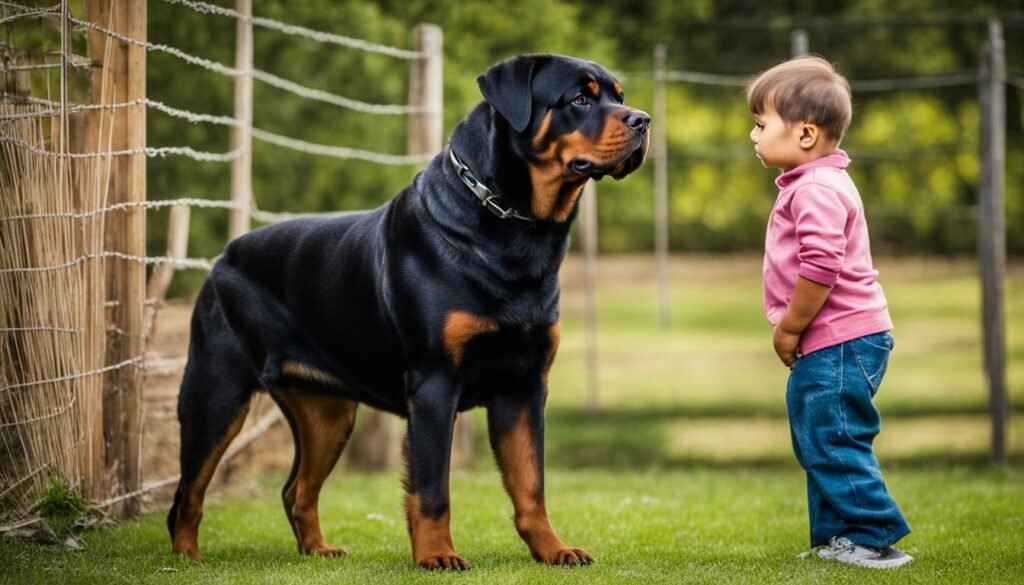
Rottweilers are known for their natural protective instincts, which can be both advantageous and challenging in a family setting. These instincts stem from their history as a working breed that was tasked with protecting livestock and property. While their protective nature can make them excellent guard dogs, it is crucial to channel this instinct appropriately through proper training and socialization.
When a Rottweiler is properly trained, they can provide a sense of security and reassurance to their family. They are known for their loyalty and dedication, often forming strong bonds with their owners and protecting them when they perceive a threat. It’s important to remember that this instinct is deeply ingrained in their nature and should be respected.
However, it’s equally important to ensure that a Rottweiler’s protective instincts are not taken to extremes. Excessive protectiveness can manifest as aggression towards strangers or even family members. To prevent this, it is crucial to establish clear boundaries and enforce consistent training and socialization from an early age.
Properly channeling a Rottweiler’s protective instincts involves distinguishing between normal situations and actual threats. This requires careful observation and understanding of your dog’s behavior. By being able to differentiate between friendly encounters and potentially dangerous situations, you can effectively guide your Rottweiler’s response.
Training your Rottweiler to respond to commands such as “sit,” “stay,” and “leave it” can be instrumental in managing their protective instincts. By teaching them obedience and providing consistent guidance, you can ensure that they respond appropriately in different situations.
Key Points:
- Rottweilers have a natural protective instinct due to their history as working dogs.
- Proper training and socialization are essential to channel their protective nature.
- Excessive protectiveness should be avoided through consistent boundaries and training.
- Understanding your Rottweiler’s behavior and distinguishing between normal and threatening situations is crucial.
- Teaching obedience commands can help manage their protective instincts effectively.
By respecting and understanding the protective nature of Rottweilers, while also providing them with proper training and guidance, you can ensure a well-balanced and harmonious relationship with your dog.
Addressing Myths: Rottweiler Aggression and Children
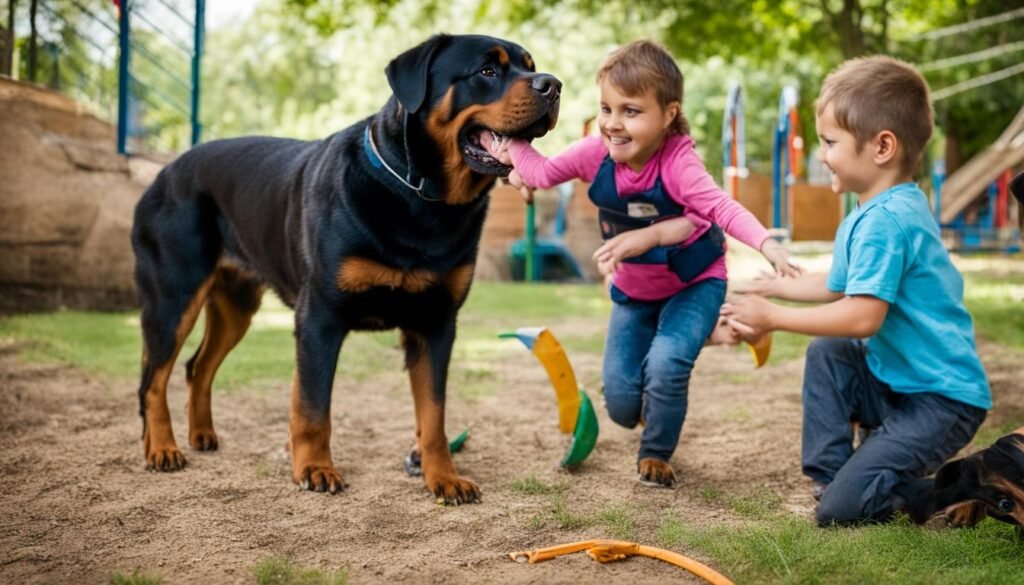
There is a prevalent myth surrounding Rottweilers that they are inherently aggressive, especially towards children. However, these assumptions are far from the truth and can be debunked with proper understanding and knowledge.
Aggression in any breed, including Rottweilers, is primarily a result of external factors such as poor training, abuse, or insufficient socialization. It is unfair to label an entire breed as aggressive based on the actions of a few individuals.
Understanding the behavior of Rottweilers is crucial in dispelling these misconceptions. When provided with adequate training and socialization, Rottweilers can be gentle and loving companions for children. It’s important to remember that any dog’s behavior is influenced by their upbringing and environment.
By investing time and effort into their training, we can prevent aggressive tendencies in Rottweilers. Consistency, positive reinforcement, and socialization from an early age play key roles in shaping their temperament.
Debunking Rottweiler Aggression Myths
- Rottweilers are not naturally aggressive: Aggression is not a characteristic specific to the Rottweiler breed. It is essential to treat each dog as an individual and focus on their upbringing rather than making assumptions based on breed stereotypes.
- Proper training and socialization is crucial: Dogs, just like humans, need guidance and positive experiences to develop good behavior. By providing a nurturing environment and exposing Rottweilers to various situations, we can ensure their well-rounded development.
- Early intervention is key: Starting training and socialization at a young age is essential in preventing and managing potential aggressive behaviors. It is never too early to begin teaching a Rottweiler how to interact appropriately with children.
It is important to educate ourselves and others about the true nature of Rottweilers. By dispelling myths surrounding their aggression, we can foster understanding and appreciation for this loyal and loving breed.
Responsible Rottweiler Ownership in a Family Setting

Owning a Rottweiler in a family with children requires a commitment to responsible ownership. To ensure a harmonious and safe environment for everyone, it is important to prioritize training, exercise, and mental stimulation.
Training is essential for a well-behaved Rottweiler. By establishing leadership and setting clear boundaries from the beginning, you can cultivate a strong and positive relationship with your dog. Consistency in your approach will help them understand your expectations and promote good behavior.
Exercise is vital for maintaining the physical and mental well-being of your Rottweiler. These energetic dogs require regular physical activity to prevent boredom and destructive behaviors. Daily walks, play sessions, and interactive toys can help fulfill their exercise needs.
Mental stimulation is equally important. Rottweilers are intelligent and need mental challenges to stay engaged and satisfied. Engage them in puzzle toys, obedience training, and interactive games to keep their minds sharp and prevent boredom.
When considering the addition of a Rottweiler to your family, it is crucial to assess if their needs align with your family’s lifestyle. Their size, energy level, and protective nature require a dedicated and committed owner. Researching the breed, consulting with experienced Rottweiler owners, and interacting with Rottweilers in various settings can help you make an informed decision.
Remember, responsible Rottweiler ownership involves investing time, effort, and resources into their training, exercise, and mental well-being. By demonstrating leadership, consistency, and providing a structured environment, you can create a loving and harmonious relationship with your Rottweiler in a family setting.
Rottweilers as Family Pets: Conclusion
In conclusion, Rottweilers can make excellent family pets when given the proper training, socialization, and care. These loyal and protective dogs can form strong bonds with children, becoming loving and reliable companions. However, it is crucial for owners to be committed and invest time in their Rottweiler’s upbringing.
By following the right approach, Rottweilers can thrive in a family environment. Early socialization and positive reinforcement training help develop their calm and confident temperament around kids. Teaching both the dog and children how to interact safely and respectfully is essential for a harmonious relationship.
Responsible ownership plays a significant role in maximizing the benefits of having a Rottweiler as a family pet. This includes providing leadership, consistency, and a structured environment. With the right love, training, and understanding, Rottweilers can bring joy, protection, and companionship to families.
FAQ
Are Rottweilers good with kids?
Rottweilers can be safe and loving around children when properly trained and socialized from a young age. Supervision during interactions is crucial, especially with younger children. It’s important to teach both the dog and the children how to interact safely and respectfully.
What is the temperament of Rottweilers around children?
Rottweilers are known for their calm and confident demeanor when properly trained and socialized. They can be gentle and loving with family members, including children. Early socialization and training are key to a well-behaved Rottweiler around kids.
How important is training and socialization for Rottweilers in households with children?
Training and socialization are crucial for Rottweilers, especially in households with children. They need to learn how to behave around kids and be exposed to different situations from a young age. A well-socialized Rottweiler is more likely to be calm and well-mannered around children.
Should Rottweilers be supervised when interacting with young children?
Yes, due to their size and strength, Rottweilers should always be supervised when interacting with young children. Teaching children how to interact safely with dogs is just as important as training the dog. Establishing rules and boundaries is crucial for the safety of both the child and the dog.
Can Rottweilers be protective of their family?
Yes, Rottweilers are naturally protective, which can be both advantageous and challenging in a family setting. Proper training is necessary to ensure their protective instinct is channeled appropriately and they do not become excessively protective or aggressive. Differentiating between normal and threatening situations is crucial.
Are Rottweilers prone to aggression towards children?
No, Rottweilers are often unfairly labeled as aggressive. Aggression in any breed is usually a result of poor training, abuse, or lack of socialization. Understanding their behavior, providing proper training, and socialization can prevent aggressive tendencies.
What does responsible Rottweiler ownership in a family setting entail?
Owning a Rottweiler in a family with children requires a commitment to training, exercise, and mental stimulation. They thrive with owners who provide leadership, consistency, and a structured environment. Ensuring they are a good fit for your family’s lifestyle is essential.
Are Rottweilers suitable as family pets?
Yes, Rottweilers can be good with children when properly trained, socialized, and treated with respect and understanding. They require a committed owner willing to invest time in their upbringing. With the right approach, Rottweilers can be loving and protective companions for families.
